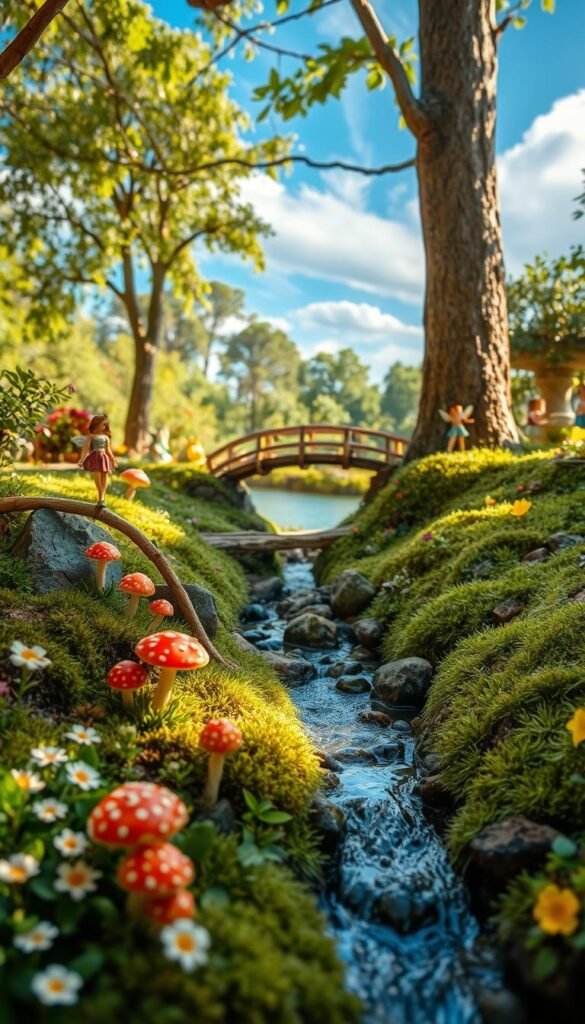Imagine transforming ordinary containers into lively tiny ecosystems where creativity blooms alongside delicate plants. These whimsical displays blend horticulture with storytelling, inviting you to design landscapes that spark joy in both kids and adults.
Rooted in centuries-old folklore about nature spirits, this tradition gained modern popularity as parents sought outdoor activities for children. Today, it’s evolved into an art form enjoyed by all ages. You can craft these miniature wonderlands in flower pots, old teacups, or even hollow tree stumps – perfect for small patios or indoor shelves.
What makes these creations special? They combine playfulness with mindfulness. Arranging tiny bridges between mossy hills or positioning miniature chairs under bonsai trees becomes a calming escape from daily stress. Families often bond while selecting pebble pathways or crafting tiny accessories together.
The secret lies in understanding scale. By mixing small-leaved plants with proportional decorations, you create convincing worlds that feel lived-in. Whether you prefer rustic woodland themes or sparkling crystal grottos, each design reflects personal style while honoring the magic of nature’s smaller wonders.
Getting Started With Your Fairy Garden
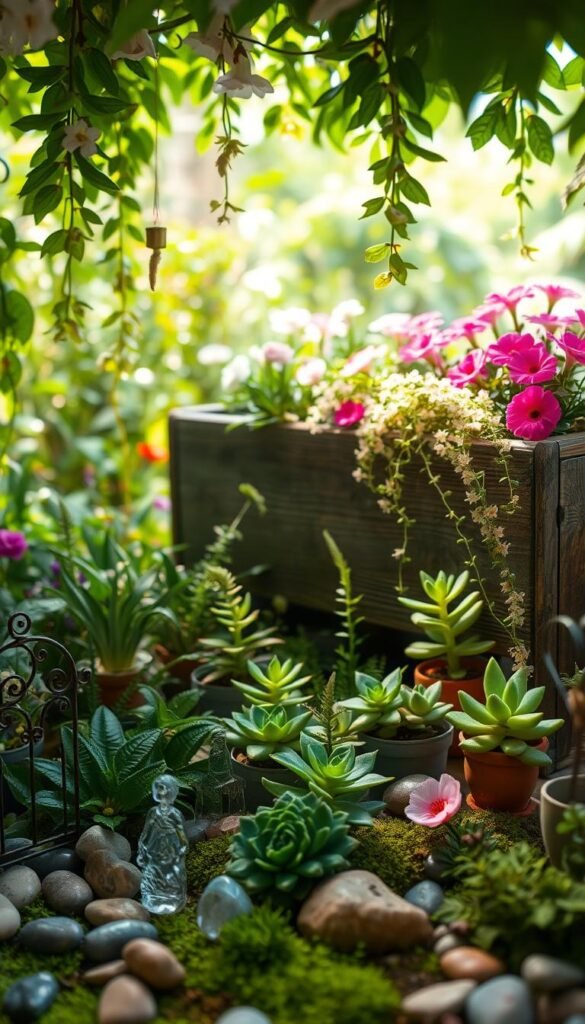
Creating your tiny paradise begins with gathering key supplies. Let’s explore what you’ll need to build a thriving small-scale scene that captivates the imagination.
Essential Materials and Tools
Start with containers that spark joy – terra cotta pots, ceramic bowls, or upcycled items like galvanized buckets work beautifully. Ensure they have drainage holes to protect roots from excess moisture. For plants, mix textures with succulents, moss, or small ferns depending on your climate.
Soil matters! Use cactus mix for drought-tolerant greens and potting soil for moisture-loving varieties. Add character with flat stones as stepping stones or colored sand for winding paths. Tiny accessories like wooden benches or handmade clay signs bring personality to your arrangement.
Keep these tools handy:
- Pruning shears for trimming overgrowth
- Tweezers to position delicate decorations
- Small brushes for dusting leaves
Setting Up Your Workspace
Choose a bright area with enough room to spread out materials. Use plastic bins to separate different soils and pebbles. Lay down newspaper for easy cleanup – those tiny rocks love to roll away!
Good lighting helps spot details when arranging mini elements. Keep a spray bottle nearby to moisten plants without overwatering. Remember: creativity flows best in organized spaces where every pebble and petal stays within reach.
Inspiration and Design Concepts
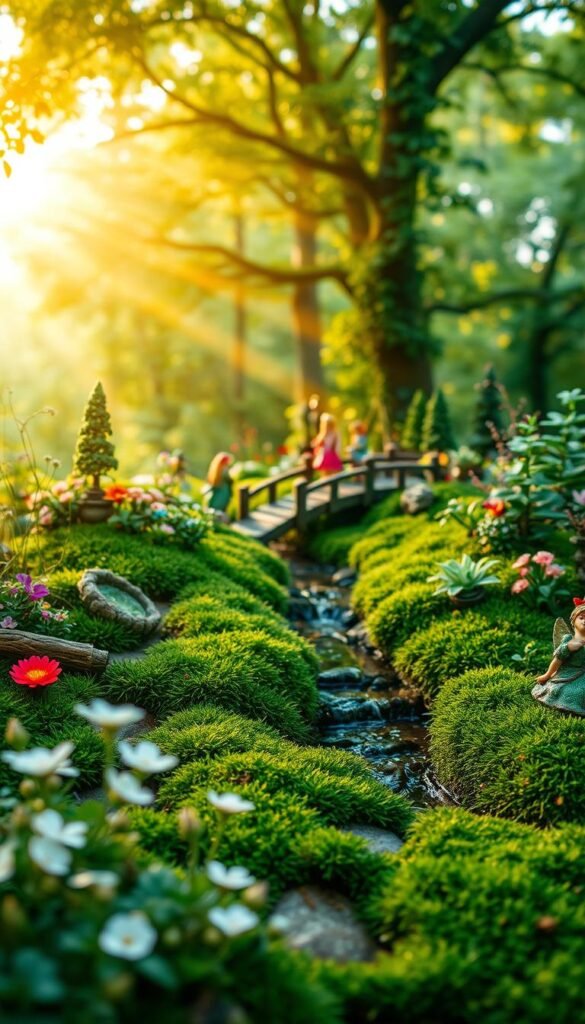
Your miniature landscape becomes a storybook when guided by a cohesive theme, offering a fun way to express creativity. Whether crafting seaside retreats with pebble beaches or woodland hideouts with mossy floors, your choices shape tiny worlds bursting with character. Designs transform random decorations into meaningful scenes that spark joy.
Finding Your Garden Theme
Popular fairy garden themes range from sunlit coastal setups to shaded forest nooks. Beach scenes thrive in bright areas using sand and succulents, while woodland designs flourish under trees with ferns and pinecones. Seasonal twists keep things fresh—think pumpkin patches in fall or blooming flowers for spring.
Match your theme to available space and light conditions. Full-sun spots suit desert motifs, while shaded corners inspire mushroom villages. Don’t shy away from unconventional ideas: herb plots with tiny pots or holiday displays attract attention year-round.
Involving kids makes the process playfully unpredictable. They’ll combine rainbow pathways with dinosaur figures, creating chaotic charm. Add fairy-sized bridges, benches, or ponds to complete your story. Every choice reflects personal style while making fairy residents feel at home.
DIY Fairy Garden Ideas to Craft a Charming Miniature World: Planning Your Project

Before planting a single sprout, strategic planning ensures your small-scale ecosystem flourishes. Start by measuring your container’s depth and width – shallow pots suit groundcover plants, while deeper ones allow for layered designs. Consider whether you’ll create a simple flat layout or add elevation with stacked stones for waterfalls.
Light exposure determines which greenery thrives. Full-sun locations need drought-resistant varieties like sedum, while shaded spots favor mosses. If you’re mixing container gardens with flowers, check their water needs to prevent root rot.
| Design Type | Best For | Maintenance | Plant Choices |
|---|---|---|---|
| Single-Level | Small spaces | Low | Moss, thyme |
| Multi-Level | Visual interest | Moderate | Succulents, ferns |
Growth management keeps your scene proportional. Fast-spreading plants need monthly trimming – use bonsai scissors for precision. Leave space between slow-growers like hen-and-chicks to prevent overcrowding.
Portability matters if you’ll move your creation seasonally. Lightweight resin containers work better than ceramic for indoor/outdoor transitions. Always plan drainage routes – drill extra holes if using repurposed items like wooden crates.
Choosing the Right Plants and Accessories
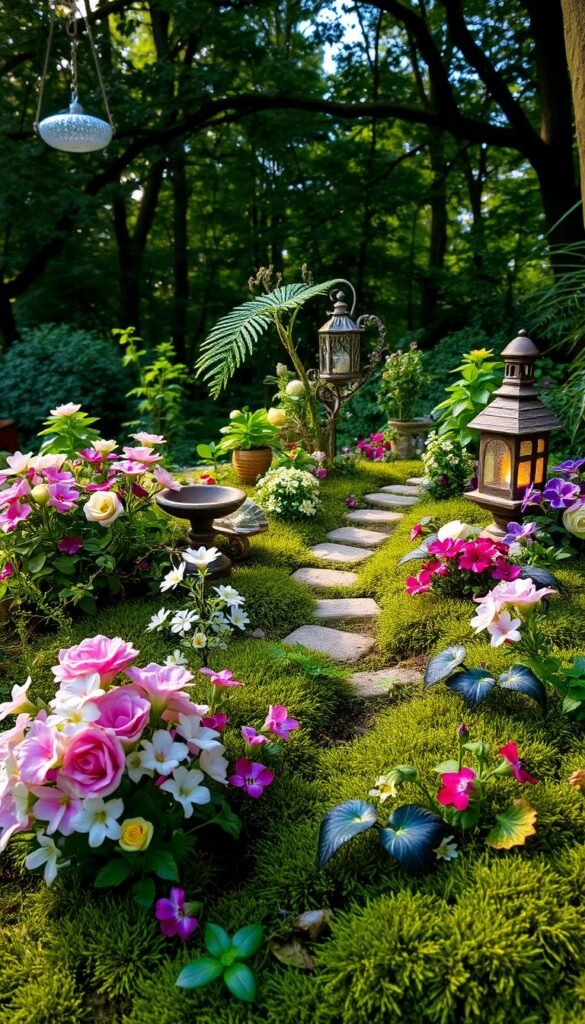
The heart of your miniature scene lies in pairing greenery with playful details. Let’s explore how to select plants and decorations that create harmony while sparking wonder.
Selecting Small Plants and Succulents
Succulents shine in dry climates with their sculptural shapes. Hens-and-chicks form rosette clusters, while string-of-pearls spills over container edges. For color variety, echeverias offer pink, blue, and purple hues. Sedums like ‘Golden Stonecrop’ add golden accents between rocks.
| Plant Type | Best Use | Water Needs | Top Picks |
|---|---|---|---|
| Succulents | Arid themes | Low | Echeveria, Ice Plant |
| Ground Covers | Pathways | Moderate | Irish Moss, Creeping Thyme |
| Flowering | Color pops | Medium | Mini Roses, African Violets |
Non-succulent options bring softness. Baby tears create lush carpets, while asparagus ferns add feathery texture. Match plants with similar light and water needs – mixing desert cacti with moisture-loving ferns leads to trouble!
Exploring Miniatures and Decorative Accents
Craft stores like Michaels stock durable resin cottages and bridges. For budget finds, Dollar Tree offers tiny tools and signs. Balance store-bought pieces with handmade touches: twist wire into trellises or use pebbles as stepping stones.
Seasonal accessories keep displays fresh. Add miniature pumpkins in fall or tiny lights during holidays. When creating patio container gardening setups, choose weather-resistant ceramics over paper decorations.
Creative DIY Elements for Unique Garden Touches
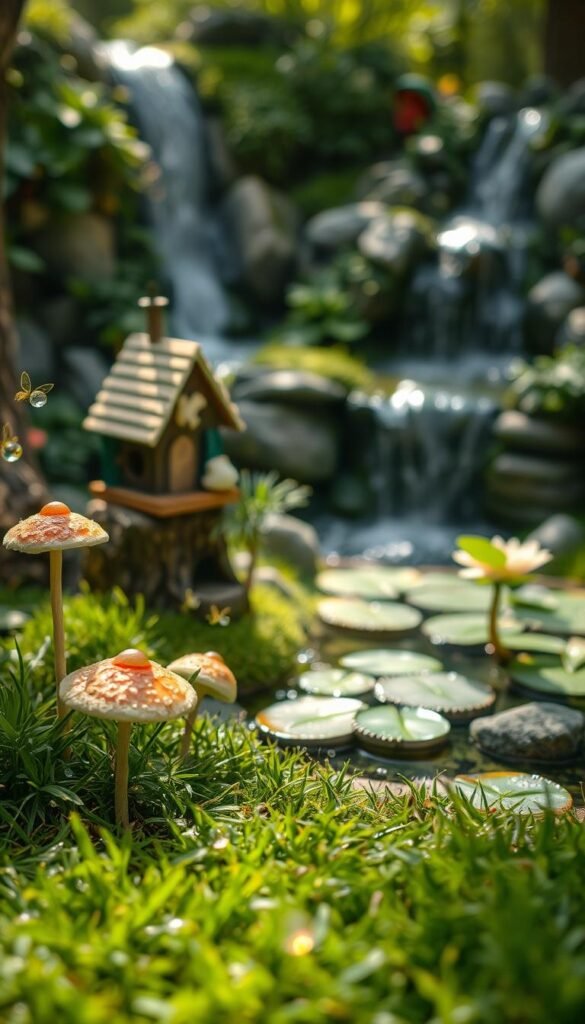
Unleash hidden magic by transforming ordinary objects into enchanting features for your miniature landscape. Nature and household items become treasure troves when reimagined through a tiny lens.
Incorporating Recycled Materials and Natural Elements
Turn backyard finds into functional art. Pine cones become towering trees when glued to wooden bases, while acorn caps make perfect fairy-sized bowls. Smooth pebbles form winding pathways, and bark slices create rustic benches that weather beautifully outdoors.
Repurpose forgotten items with clever twists. Broken pottery pieces stack into colorful cottage walls, and bottle caps transform into shimmering ponds with blue marbles as water. Fabric scraps flutter as miniature flags when tied to twig poles with durable twine.
| Material Type | Best Projects | Durability Tips |
|---|---|---|
| Natural (Pine cones, stones) | Path borders, furniture | Seal with clear varnish |
| Recycled (Bottle caps, tiles) | Walls, decor accents | Use waterproof glue |
| Wood & Bark | Structures, roofing | Choose rot-resistant types |
Rock painting adds personality to your scene. Try simple dot patterns or tiny mushroom designs using acrylic paints sealed with outdoor-safe spray. For lasting creations, use thick wood scraps instead of popsicle sticks – they withstand rain and won’t warp.
Collect materials during nature walks. Look for curved twigs that become arched bridges or flat stones for patio areas. Shells and sea glass work beautifully in coastal-themed setups, especially when paired with blue gravel “water” features.
Fun with Fairy Garden Projects for Kids
Spark wonder in young minds by blending nature play with imaginative storytelling. These tiny landscapes offer endless opportunities for kids to explore textures, colors, and creative problem-solving. Pair this activity with easy seed-starting projects to nurture their curiosity about plant life cycles.
Growing Creativity Through Play
Preschoolers thrive when designing their magical realms. Let them paint rocks with wild patterns or arrange twigs as fairy furniture – there’s no wrong way to make fairy spaces feel alive. Their whimsical choices often lead to unexpected delights, like upside-down flowerpot houses or pebble-lined rivers.
Turn garden time into bonding time. Families can host themed birthday parties where guests build mini scenes in take-home containers. Document these moments by snapping photos for your next social media post – kids love seeing their creations celebrated!
Through playful collaboration, you’ll create more than just charming displays. You’re cultivating memories that grow sweeter with time, rooted in shared laughter and muddy-handed adventures.

